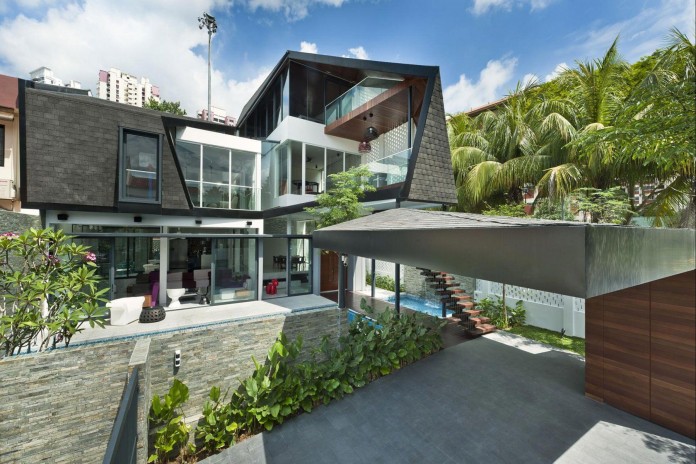Jalan Binchang House by A D Lab
Architects: A D Lab
Location: Singapore
Year: 2012
Photos: Edward Hendricks
Description:
This calm low-ascent parkway of semi isolates houses at Jalan Binchang is like numerous in Singapore. Built for the most part in the 1970’s, the sets of two story block houses are presently at the stage in their building lifespan where remodel is famous. The creators saw the advancement of the curious neighborhood and its normal development as a primary wellspring of motivation in the outline of no. 67 Jalan Binchang.
They conceptualized on the best way to develop and revive the current semi segregated house while keeping up an agreement with the current manufactured environment, the historical backdrop of tropical private structures and with the regular habitat.
The creators took a gander at the current building as one would examine a living being that expected to adjust to another environment. Rather than wrecking its implanted history and rethinking it as something totally new, they chose to utilize its structure, its inward rationale of association and importance as a beginning stage to the outline, and to expand upon this prior example and structure to develop it into another shape and space.
The modelers think that its critical to concentrate how space can develop with time and with the changing states of the tenants so that the lifespan of development can be expanded. Likewise as a method for decreasing waste, reserve funds cost on the task, and minimizing interruption to the neighbor’s home, the creators chose to hold the whole 2-story semi segregated house on the site. Between this structure and a recently included 2 story in addition to upper room expansion, a crevice between the old and new structures was kept to bring light and twist through the house and to take into account the settlement of the new structure autonomously from the old. The interior building’s rationale of the front confronting open room, back confronting administrations and private second story of the current house was kept up and persisted to the side augmentation.
In another push to minimize material, and also to connect the two structures together, the architects utilized the fifth rise of the house, the rooftop structure, as the principle façade of the old and new parts of the building. They twisted and collapsed this structure around the top and sides of the house. This rooftop was considered as a development of the conventional slanting peak tropical rooftop and holds the historical backdrop of the visual and capacity significance of the rooftop in the tropics.
The naturally wrapping free rooftop makes a protecting support between the unforgiving tropical sun and the inside and outside living spaces beneath. An illustration of asset adequacy in the configuration is the utilization of straightforward, locally accessible materials to develop a “breathing” divider out of naturally composed painted block on the North-East face of the building.
This multi-utilitarian porous divider chops down clamor from the adjacent Category 3 street of Bishan Street 22 and also permits the overall winds to course through the building and to decrease heat in the house in order to bring down the building’s reliance on aerating and cooling. Tastefully, this breathing divider makes delightful examples of light over the inward surfaces of the house, making a quiet and tranquil air where space is in congruity with its history, its atmosphere and with the common components.





















